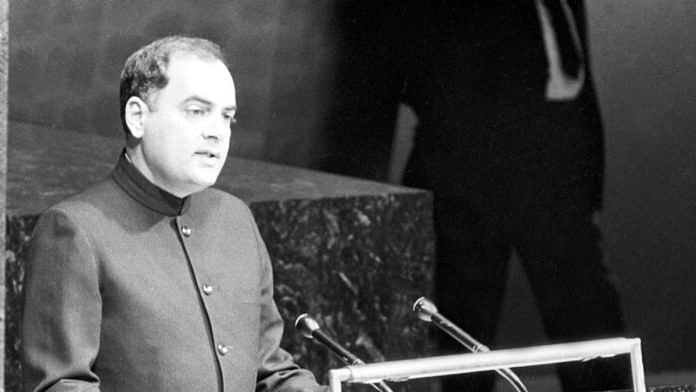I took charge as official spokesman and joint secretary (external publicity) – JS (XP) – of the ministry on 12 January 1982. The perks included a chauffeured car. In the ministry, it was believed the JS (XP) only went to ‘high-fliers’ but I soon found as spokesman that I was just parroting the views of other officers with substantive portfolios. I thought I would much rather be heading a territorial desk than acting the role of a caged parrot. Hoping I could soon secure such an assignment, I got on with the job on hand.
One day I received a call from Vasant Sathe, minister of information and broadcasting (I&B), to attend a meeting on external publicity where ‘Rajivji’ would also be participating. Ministers and MPs were seated on sofas. Officers were seated opposite them on straight-backed chairs. Rajiv Gandhi arrived a little late. As he sat down, he started surveying the assemblage looking for a familiar face. I saw his eyes briefly light up when he spotted me.
I was still in Karachi in my mind. So, after the meeting ended, I went up to him and asked if I could set up a meeting with him as I had something important to impart arising out of my previous posting. He nodded graciously and asked me to get in touch with his private secretary, Vincent George.
Suneet and I fetched up at 1, Safdarjung Road. Rajiv joined us and I launched my crusade. I briefly summarized my experience of Pakistani public opinion and said I thought an emotional breakthrough was the prime necessity, what I called a ‘goodwill blitzkrieg’.
Rajiv Gandhi, I said, held no formal office other than being a backbench MP but, of course, the whole world knew that he was the Indian PM’s son. Hence, if he visited Pakistan, nothing he said would be binding on the Government of India; yet, as it was the atmospherics that needed to be set right, I gave him the example of Crown Prince Edward’s highly successful personal visit to France that led to the Anglo-French entente cordiale of 1904.
I suggested that he ask to see Mohenjodaro, from where he should drive to Karachi via Sehwan Sharif or Bhit Shah or, best of all, both, for both promoted Sufi Islam that reconciled the two major communities. At both shrines, worshippers included Muslims and Hindus. One of the two sajjada nashins (managers of the shrine) of Sehwan Sharif was always a hereditary Hindu and it attracted a million worshippers every year. The Hindus revered the saint as ‘Jhule Lal’ (god of the waters – the Sindhu dariya, or Indus). Others revered him as ‘Mast Qalandar’, the inspiration for the immortal qawwali ‘Dama Dam Mast Qalandar’, which was the unofficial anthem of the PPP. Similarly, Bhit Shah, the shrine dedicated to Shah Abdul Bhittai, Sind’s greatest poet, was revered by both communities and was famed for its evening qawwalis that combined high culture with deep spirituality.
It was the eclectic spirit cultivated at these shrines that had forestalled the outbreak of communal rioting in Sind until the muhajir from Uttar Pradesh arrived and provoked the exile of the Hindu community. Rajiv Gandhi’s arrival in Karachi after visiting these two shrines, I assured him, would draw huge crowds and he would be received with wild enthusiasm. This rapturous welcome would be beamed into every drawing room in India and Pakistan and would open the way, through negotiations, to a possible entente cordiale between India and Pakistan. He seemed interested but non-committal. However, I think I did strike a chord that reverberated when he became, in 1988, the first Indian PM in twenty-eight years to visit our ‘distant neighbour’.
 This excerpt from ‘Memoirs of a Maverick: The First Fifty Years (1941–1991)’ by Mani Shankar Aiyar has been published with permission from Juggernaut Books.
This excerpt from ‘Memoirs of a Maverick: The First Fifty Years (1941–1991)’ by Mani Shankar Aiyar has been published with permission from Juggernaut Books.



